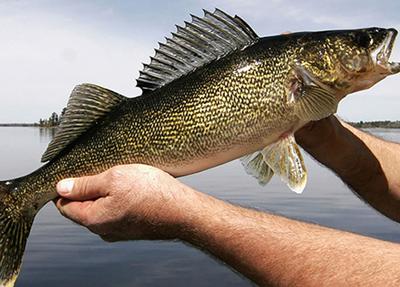Lake Erie’s dominant predator spends much of its time chasing food in the dark — at night and at depths that obscure most light frequencies. Named for their odd pearlescent eyes, walleye can distinguish colors in various water conditions and see in shades of darkness that blind their prey
Veteran walleye anglers and fishing guides base strategies on the fish’s evolutionary visual advantages. But scientific research on the species hasn’t kept up with studies of freshwater bass and trout, despite the walleye’s natural range stretching from the Arctic to Alabama.
A recent study at Ohio State University explored precisely what walleye can see in various water conditions. Some of the research confirmed details that anglers have long suspected. In clear water, the study found, walleye will strike white lures or almost any color. When the water is clouded by sediment, they are more likely to go for yellow or gold, and in green algae-laden waters, walleye eyes are best at seeing black.
Suzanne Gray, a professor of environment and natural resources at Ohio State, researches why and how some animals can adapt easier than others to human-induced environmental changes. She was initially attracted to Lake Erie walleye because of their exceptional visual skills and exposure to annual algal blooms in their spawning waters in the warm shallows of the lake’s western basin. Human-induced nitrogen-rich agricultural runoff causes the blooms, which can grow dense, massive and spread across half of Lake Erie.
Gray recently explained some of her research in a webinar angled for anglers and hosted by Ohio State and Ohio Sea Grant, a research, education and outreach center linked to the National Oceanic and Atmospheric Administration.
“From my perspective, I think of individual fish and how they respond to environmental stressors, whether that’s changes in the color and clarity of the water or changes in the temperature of the water,” she said. “How do fish sense those changes internally? Do they then react and respond, and what does that mean across the lifespan of the fish and the community of fish?”
Some rely on smell. Other fish feel disturbances in the water through the sensitive lateral line. The walleye’s eyes evolved as its predominant sense. The bulbous organs find food and avoid predators even through dense algal matting and mud or other sediment from waves or tributaries. The eyes detect movement under high waves and have acuity at water depths beyond the reach of visual light (about 33 feet below the surface of clear water). Walleye rely on sight to spawn, to scan the water during the twilight of dusk and dawn, during starless nights and when a bright moon casts stark silhouettes.
Some of what Gray has learned about walleye eyes may help anglers make decisions about lure color choices in degrees of water clarity.
“These are very visually dominated fish, so they use vision for a lot of different tasks,” she said. “Then, of course, there’s the human dimension. [Anglers] are likely to spend some time thinking about what lure you’re going to use each time you go to catch fish. In the case of walleye they are visual hunters. They have color vision, they can see in really low light. We know these things. So really understanding what they see under different conditions is pretty important to this recreational angling industry, which is worth about $2 billion a year in Ohio.”
Gray and her research team conducted a lab test to document the basic visual abilities of walleye under various water color and clarity conditions. A phone app was developed and Lake Erie charter captains were recruited to log data noting lure color, water color and clarity as well as clients’ walleye catches during various levels of water turbidity. The researchers used that information to make predictions about the walleye bite when using lures of particular colors under various water conditions. Finally, they tested those predictions in a controlled fishing experiment.
As expected, the initial laboratory testing confirmed that visual perception decreased in water clouded with sediment, and was further degraded in mixed sediment and algae. When the water contained algae only, however, walleye vision reduced 40% as compared with what they could see in sediment. Also, to detect prey in algal waters, walleye needed to be 15% closer than in sediment.
The charter captains’ data showed base lure color success varied by water clarity and color. This part of the research found that white lures outfished other colors when the water was clear. Yellow and gold were hot in water clouded with sediment. But when waters were green with algae, more walleye were caught on black and purple lures.
In the controlled fishing experiment, grad students performed the hard work of fishing in Lake Erie. They logged lure color, water clarity and time of day to test the predictions developed using data from the previous testing. They took six fishing trips in clear water, six in turbid water and three trips during algal blooms. Four people were fishing at a time, each with a different lure color.
“For our experiment we used this analysis to understand if fish preferred any of these four lure colors in a given water condition,” said Gray. “What we found was that in clear water ... there was no preference, they would just pick whatever color they saw first, maybe. In sedimentary turbid conditions ... given all the lure colors, the probability that the fish were going to strike on a gold lure is much higher. Under algae conditions ... when given a choice between all four colors, the fish seemed to prefer black.”
Despite low sample sizes and reduced research in algal waters, Gray said the experiment confirmed that in various water conditions walleye could see some colors better than others, and proved that researchers could predict walleye lure color preferences in various water conditions.
That’s what fishing guides successful walleye anglers do on every trip. But conducted in controlled conditions, the study put some PhD credibility behind knowledge of an important yet understudied game species.




























Commented
Sorry, there are no recent results for popular commented articles.